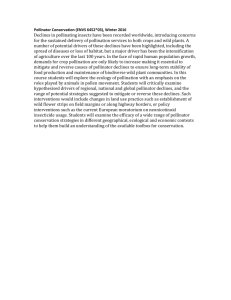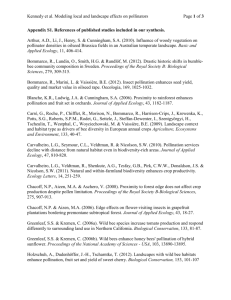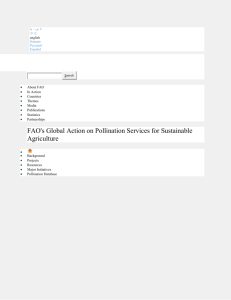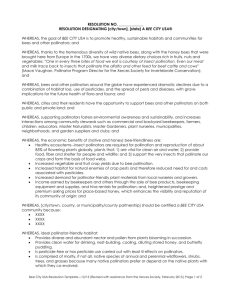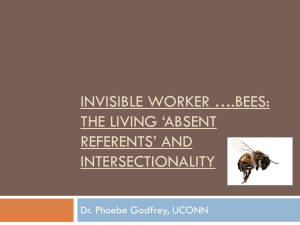English - Convention on Biological Diversity
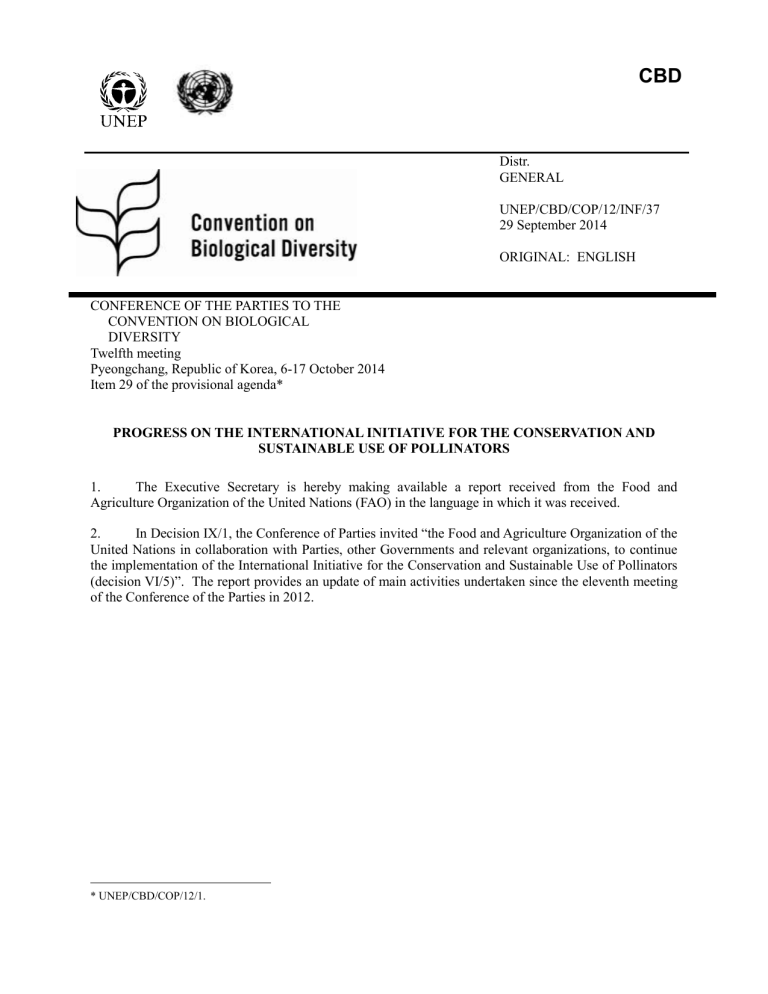
CBD
Distr.
GENERAL
UNEP/CBD/COP/12/INF/37
29 September 2014
ORIGINAL: ENGLISH
CONFERENCE OF THE PARTIES TO THE
CONVENTION ON BIOLOGICAL
DIVERSITY
Twelfth meeting
Pyeongchang, Republic of Korea, 6-17 October 2014
Item 29 of the provisional agenda*
PROGRESS ON THE INTERNATIONAL INITIATIVE FOR THE CONSERVATION AND
SUSTAINABLE USE OF POLLINATORS
1.
The Executive Secretary is hereby making available a report received from the Food and
Agriculture Organization of the United Nations (FAO) in the language in which it was received.
2.
In Decision IX/1, the Conference of Parties invited “the Food and Agriculture Organization of the
United Nations in collaboration with Parties, other Governments and relevant organizations, to continue the implementation of the International Initiative for the Conservation and Sustainable Use of Pollinators
(decision VI/5)”. The report provides an update of main activities undertaken since the eleventh meeting of the Conference of the Parties in 2012.
* UNEP/CBD/COP/12/1.
UNEP/CBD/COP/12/INF/37
Page 2
PROGRESS ON THE INTERNATIONAL INITIATIVE FOR THE CONSERVATION AND
SUSTAINABLE USE OF POLLINATORS
Convention on Biological Diversity
COP 12
6 - 17 October 2014
Pyeongchang, Republic of Korea
TABLE OF CONTENTS
I.
INTRODUCTION
II. ASSESSMENT
III.
ADAPTIVE MANAGEMENT
3
3
7
IV.
CAPACITY BUILDING
V.
MAINSTREAMING
VI.
REFERENCES
8
9
10
UNEP/CBD/COP/12/INF/37
Page 3
PROGRESS ON THE INTERNATIONAL INITIATIVE FOR THE CONSERVATION AND
SUSTAINABLE USE OF POLLINATORS
I.
INTRODUCTION
Considering the urgent need to address the issue of the worldwide decline in pollinator diversity, in 2000 the Fifth Conference of the Parties to the Convention Biological Diversity established an International
Initiative for the Conservation and Sustainable Use of Pollinators (also known as the International
Pollinators Initiative-IPI) (COP decision V/5, section II). The CBD Executive Secretary was requested to
“invite the Food and Agriculture Organization of the United Nations to facilitate and co-ordinate the
Initiative in close co-operation with other relevant organizations.” In particular, the development of a plan of action was requested, and the IPI Plan of Action was prepared by FAO and the CBD Secretariat (COP decision VI/5, in 2002) with four elements: assessment, adaptive management, capacity building and mainstreaming.
In 2008, in Decision IX/1, the Ninth Conference of Parties (COP) invited “the Food and Agriculture
Organization of the United Nations in collaboration with Parties, other Governments and relevant organizations, to continue the implementation of the International Initiative for the Conservation and
Sustainable Use of Pollinators (decision VI/5) and, in particular:
Complete information on pollinator species, populations and their taxonomy, ecology and interactions;
Establish the framework for monitoring declines and identifying their causes;
Asses the agricultural production, ecological and socio-economic consequences of pollinator declines;
Compile information on best practices and lessons learned;
Develop response options to promote, and prevent the further loss of, pollination services that sustain human livelihoods;
Disseminate openly the results through the CHM and other relevant means.”
This information document is organized according to the elements of the Plan of Action of the
International Pollinators Initiative (IPI). It provides an update of main activities undertaken since 2012, when the previous information document was submitted to COP-11. The information presented in this paper is based on consultations with, and information gathered from, individuals and institutions actively contributing to the Plan of Action of the IPI. This is the Third Information Document to the CBD prepared by FAO, on progress on the IPI.
II.
ASSESSMENT
In the past two years, considerable research has been undertaken and reported upon in the areas of assessing pollinator status and trends, benefits of pollination, the relative importance of different pollinator groups, and threats to pollinators.
Multiple benefits of pollination: to crop shelf life, reducing food waste
The full contribution of pollination to crop quality is still unknown; however in a recent study ( Klatt et al.
2014) , exclusion experiments with strawberries showed bee pollination to improve fruit quality, quantity and market value compared with wind and self-pollination. Bee-pollinated fruits were heavier, had fewer malformations and reached higher commercial grades. They had increased redness and reduced sugar and were firmer, thus improving the commercially important shelf life. Longer shelf life reduced fruit loss by at least 11%.
UNEP/CBD/COP/12/INF/37
Page 4
Multiple benefits of pollination: to production and human nutrition
Almond production in California has been the focus of considerable research and attention, given its striking dependence on pollinators, and impacts on what is now a global market of the pollination services. An international team of researchers have shown that a lack of bees and other wild insects to pollinate almonds can reduce harvest yields more drastically than a lack of fertilizer or a failure to provide the crops with sufficient water (Klein et al. 2014). On the other hand, when almonds are adequately pollinated, the trees bear more fruit and their nutrient content changes, with increases in Vitamin E
(Brittain et al. 2014).
Importance of wild pollinators
In a wide-ranging meta-analysis published in Science in 2013, the pollination of more than 40 crops in
600 fields across every populated continent was studied through a contribution of 46 scientists (Garibaldi et al. 2013). It was found that wild pollinators were twice as effective as honeybees in producing seeds and fruit on crops including oilseed rape, coffee, onions, almonds, tomatoes and strawberries.
Furthermore, bringing in managed honeybee hives did not replace wild pollination when that was lost, but only supplemented the pollination that took place.
The new research indicates the substantial contribution of wild insects and suggests that honeybees cannot replace the wild insects lost as their habitat is destroyed. The lead author, Lucas Garibaldi, said relying on honeybees was a "highly risky strategy" because disease can sweep through single species, as has been
UNEP/CBD/COP/12/INF/37
Page 5 seen with the varroa mite, and single species cannot adapt to environmental changes nearly as well as a group of wild pollinators. Garibaldi's team warned that: "Global degradation of natural services can undermine the ability of agriculture to meet the demands of the growing, increasingly affluent, human population." Wild pollinators perform better than honeybees because they deploy a wider range of pollinating techniques, such as "buzz" pollination. They also visit more plants, meaning much more effective cross-pollination than honeybees, which tend to carry pollen from one flower to another on the same plant.
Status of Pollinators – Bumblebees in Europe
Sixteen of Europe’s 68 bumblebee species are at risk of extinction, according to a new report from the
Red List of the International Union for Conservation of Nature (IUCN 2014). The report also noted, “Of the five most important insect pollinators of European crops, three are bumblebee species. The populations of almost half of these European bumblebee species are falling and just 13 percent are increasing”, it said. The assessment, the first by the Red List to look at bumblebees, identified the main threats as climate change, which is altering their habitat, and changes in agricultural land use that is causing their natural environment to disappear.
Another study which used data collected in Belgium, Britain and the Netherlands showed a slowing down in declines of bee populations ( Carvalheiro, L.G. et al. 2013) . It found a 30 per cent fall in local bumblebee biodiversity between the 1950s and the 1980s (although the decline slowed to an estimated 10 per cent in Britain by 2010, while in Belgium and the Netherlands bumblebee diversity had stabilized).
Status of Pollinators – in the USA
Bumblebees
In 2013 a petition was filed with the U.S. Fish and Wildlife Service to protect the Rusty Patched Bumble
Bee ( Bombus affinis ) in the US, currently threatened with extinction. This bee was once very common from the Upper Midwest to the East Coast and was an important pollinator of crops and wildflowers, but recently it has undergone a precipitous decline. Historically known from more than twenty-five states, a recent study estimates that the rusty patched bumble bee (Bombus affinis) has disappeared from 87 percent of its historic range. Where it is still found, this bee is much less abundant than it was in the past.
Honeybees
Honeybee declines over the winter period in the USA remain a concern. Although honeybee reported deaths were lower in the winter 2013-2014 (23.2 percent) than in winter 2012-2013 (30.5), the figure is higher than the 30.5 percent loss reported in the winter of 2011-2012. Previous surveys found total colony losses averaged 29.6 percent over the last eight-year span. (http://beeinformed.org/2014/05/colony-loss-
2013-2014/)
Status and trends of plant- pollinator interactions
A study, using historic data, quantifies the degree to which global change over the past 120 years has disrupted plant-pollinator interactions, in a temperate forest understory community in Illinois, USA. The study found a degradation of interaction network structure and function and extirpation of 50% of bee species. Network changes were attributable to shifts in forb and bee phenology, resulting in the quality and quantity of pollination services to decline, over time. While the historic network showed flexibility in response to disturbance, data collected during this study suggested that networks would be less resilient to future changes ( Burkle et al. 2013).
UNEP/CBD/COP/12/INF/37
Page 6
Threats to Pollinators- Interactions between drivers
Research is still being conducted on the causes of bee declines around the world, and in particular in
Europe and North America. Pesticides and disease (including the varroa mite but also the tobacco ringspot virus (TRSV) – have been highlighted in a report from scientists affiliated with USDA and the
Chinese Academy of Agricultural Sciences (Li et al. 2014).
Yet another study argues that multiple anthropogenic pressures – including land-use intensification, climate change, and the spread of alien species and diseases – are primarily responsible for insectpollinator declines, and show that a complex interplay between pressures (eg lack of food sources, diseases, and pesticides) and biological processes (eg species dispersal and interactions) at a range of scales (from genes to ecosystems) underpins the general decline in insect-pollinator populations
(Vanbergen et al. 2013).
Threats to Pollinators- Diseases and Pesticides
Research results produced in 2014 (Furst et al) provided evidence to suggest that emerging infectious diseases may be contributing to a decline in populations of some important insect pollinators. Two serious honeybee ( Apis mellifera ) pathogens in a wild pollinator were shown capable of infecting the bumblebee
( Bombus terrestris ), in laboratory experiments in the UK. Moreover, data from across the United
Kingdom show that there is co-occurrence of deformed wing virus (DWV) and the microsporidian parasite Nosema ceranae in the two species of pollinators. Thus wild pollinator populations may be at risk from the diseases that affect honeybees, and unlike managed populations of Apis , they are not protected by intervention from beekeepers. credit: M. Furst
There is also evidence that pollinator status is threatened by a combination of diseases and pesticide use.
Specifically, there has been shown to be a significant interaction between neonicotinoid exposure and parasite infection on bumble bee mother queen survival. This in turn is intrinsically linked to colony success, and under combined pressure of parasite infection and neonicotinoid exposure, mother queen survival was lowest (Fauser-Misslin et al. 2014).
Threats to Pollinators – Fungicides
While it has generally been assumed that fungicides are fairly safe for honey bees, research produced in
2013 (Pettis et al. 2013) found an increased probability of Nosema parasite infection in bees that
UNEP/CBD/COP/12/INF/37
Page 7 consumed pollen with a higher fungicide load. The authors note that these results “highlight a need for research on sub-lethal effects of fungicides and other chemicals that bees placed in an agricultural setting are exposed to.”
Threats to Pollinators- Winter Survival
Research of the impacts of sub-lethal hive exposure to neonicitinoid pesticides (Lu et al 2014) showed that both exposed and control hives progressed almost identically through the summer and fall seasons, with no acute morbidity or mortality in either group until the end of winter. However, bees from six of the twelve neonicotinoid-treated colonies had abandoned their hives, with a complete opposite phenomenon in the control colonies. Only one of the six control colonies was lost due to Nosema -like infection. The author suggest that observations from this study may help to elucidate the mechanisms by which sublethal neonicotinoids exposure cause honey bees to abandon hives in winter.
Threats to Pollinators- Long term effects of pollinator decline from radiation on agroecosystems
A re-investigation of ecosystem function in the area of the 1986 Chernobyl nuclear accident provides some insight into long-term effects of pollinator declines at large geographic scales. In a recent study
(Moller 2012), it was shown that twenty-five years later in the Chernobyl region, there were considerably fewer pollinating insects in areas with high levels of radiation. Fruit trees and bushes (apple Malus domestica , pear Pyrus communis , rowan Sorbus aucuparia , wild rose Rosa Rugosa spp.
, twistingwood
Viburnum lantana , and European cranberry bush Viburnum opulus ) that are all pollinated by insects produced fewer fruit in highly radioactively contaminated areas, partly linked to the local reduction in abundance of pollinators.
III.
ADAPTIVE MANAGEMENT
Wildflower plantings next to crops
Using highbush blueberry as a model system (Blauw and Isaacs 2014), the efficacy of using wildflower plantings adjacent to crop fields to increase the abundance of wild pollinators during crop bloom and enhance pollination and yield was tested in the United States and reported on recently. Plantings were seeded with a mix of 15 perennial wildflower species that provided season-long bloom. The effect of these plantings was on wild bee populations: honeybees visiting blueberry flowers had similar abundance in enhanced and control fields in all 4 years of this study, whereas wild bee and syrphid abundance increased annually in the fields adjacent to wildflower plantings. The enhanced presence of wild bees significantly increased the percentage fruit set, berry weight and mature seeds per berry leading to higher crop yields; the associated increased revenue exceeded the cost of wildflower establishment and maintenance.
Managing for Pollinators and Natural Enemies Simultaneously
To manage agroecosystems for multiple ecosystem services, it will be important to know whether the management of one service has positive, negative, or no effects on other services. With respect to the interactions between pollination and pest-control services, a recent study (Shackleford et al 2013) carried out a meta-analysis on the distributions of pollinators and natural enemies in agroecosystems. They found that some pollinators and natural enemies seem to have compatible responses to landscape complexity, and it might be possible to manage agroecosystems for the benefit of both. However, too few studies have compared the two, - and very few of these studies have been carried out in developing countries.
Evolving markets for pollinators
Pollination services are evolving from a locally-produced service to — in countries with more intensive
UNEP/CBD/COP/12/INF/37
Page 8 agriculture — the product of an extensive market that ranges over vast geographic areas through migratory beekeeping. In the United States, for example, the demand for bees to pollinate California almonds has sharply increased over the last 25 years, exceeding the amount (estimated at 90%) of beekeepers in California in the early 1970s, and regionally in the late 1970’s (Rucker et al. 2012).
Economic studies show that evolving pollination markets are responsive to changes in economic factors and to meeting the increased demand.
Adaptive management of the pollinator itself
On a note of interest, pollinators themselves are showing adaptation behaviours to their changing environment – specifically, an environment increasingly polluted with plastics. A 2013 study ( MacIvor &.
Moore 2013) showed that two species of megachilid bee used different types of polyurethane and polyethylene plastics in place of natural materials to construct and close brood cells in nests containing successfully emerging brood. The study found that the plastics collected by each bee species resembled the natural materials usually used by these bees. Megachile rotundata , which uses cut plant leaves, was found constructing brood cells out of cut pieces of polyethylene-based plastic bags, and Megachile campanulae , which uses plant and tree resins, had brood cells constructed out of a polyurethane-based exterior building sealant.
IV.
CAPACITY BUILDING
Education and training
Capacity building is on-going, globally, at different levels of intervention. At the farm level, farmers are provided opportunities to explore pollination, the farm ecosystem, and ecological interactions through the
UNEP/CBD/COP/12/INF/37
Page 9
Farmer Field Schools approach. Through Farmer Field Schools, trainers are trained on specific issues, and they in turn train farmer groups. In Nepal, for example, these groups have been very successful, and in some communities, farmers who have received training share information with their neighbours. The formal education level has also been targeted, for example para-taxonomic courses (e.g. in India), or inclusion of pollination in school curriculum (e.g. in Ghana, where pollination is taught even at the primary school level). International bee courses are also held (e.g. in Brazil).
Building capacity through public awareness
Many countries are aware that building capacity involves not only of farmers, but also the general public, and is equally important. Different countries have been approaching this in ways that are specific to their circumstances, however, globally, public awareness strategies are developed (considering different audiences), and campaigns are being undertaken. Information dissemination has taken different formats, ranging from: media outlets (newspaper, radio); public speaking and/or lectures; attendance at fairs, including agricultural fairs; development and dissemination of brochures, leaflets, pamphlets; posters;
DVD’s; and internet, among others. The African Pollinator Initiative, for example, is reviving its visibility using Internet, through a Mendeley Group. Through Mendeley, members of the group can exchange information, including scientific papers.
V.
MAINSTREAMING
Identifying wild pollination conservation needs for science policy
For a number of reasons, including the importance of pollinators to food crop production, pollinator conservation and pollinator declines, it was deemed that in order to deal with these issues, it was necessary to identify knowledge needs that can guide future science policy. To this effect, In the UK, a list of 246 knowledge needs relating to conservation of wild insect pollinators was identified by
“conservation practitioners”, including representatives from UK industry (including retail), environmental non-government organisations and nature conservation agencies. From these 246 knowledge needs, the list was refined to select for the most important knowledge needs, through a three-stage process of voting and scoring, including discussions of each need at a workshop. 35 top knowledge needs were identified – it is envisaged that these will structure ongoing work to make science accessible to practitioners, and help to guide future science policy and funding ( Dicks et al. 2013).
Policy for multiple ecosystem services, with a focus on pollination
A range of policy initiatives have been promoted in recent years to address the decline of bee populations in Europe and North America. Among these has been
The establishment of flower-rich habitat within or around intensively farmed landscapes to increase the availability of pollen and nectar resources has been proposed in numerous national policy initiatives to address the declines in pollinators. These often consist of:
fields planted with temporary flowering cover crops,
field borders with perennial or annual flowering species,
hedgerows comprising prolifically flowering shrubs, grass buffer strips (used to manage erosion and nutrient runoff) which are supplemented with dicotyledonous flower species.
As noted by Wratten et al (2012), these measures to conserve pollinator habitat may also enhance overall biodiversity and the ecosystem services it provides (including pest population reduction), protect soil and water quality by mitigating runoff and protecting against soil erosion, and enhance rural aesthetics. Thus,
UNEP/CBD/COP/12/INF/37
Page 10 it is recommended to incorporate these secondary benefits into decision-making processes, to help stakeholders to assess the trade-offs implicit in supplying ecosystem services.
Pesticides
Increasing attention is being paid to the linkages between pesticide use and pollination services.
Publications such as “Assessing the risk if pesticides to wild pollinators”, and the newly published companion guide on “Pollination safety in agriculture” are examples of how practitioners are concerned about the issue and request guidance material (Both produced by FAO in the context of the Global
Pollination Project and available for download from www.internationalpollinatorsinitiative
under the documents tab). In terms of mainstreaming to the level of the broader public, pesticide labeling is becoming more explicit in favour of pollinators (e.g. USA’s EPA new and strengthened label requirements).
Presidential Memorandum on Pollination in the United States
In 2014 in the United States, President Obama issued a wide-reaching memorandum on pollination, on
“Creating a Federal Strategy to Promote the Health of Honey Bees and Other Pollinators”. The presidential memorandum noted that:
“Given the breadth, severity, and persistence of pollinator losses, it is critical to expand Federal efforts and take new steps to reverse pollinator losses and help restore populations to healthy levels.”
The memorandum established the Pollinator Health Task Force, co-chaired by the Secretary of
Agriculture and the Administrator of the Environmental Protection Agency. and the heads, or their designated representatives, from more than 14 Departments and high-level federal institutions. The Task
Force has been charged with developing a National Pollinator Health Strategy with 180 days of the issuance of the memorandum, including specific instructions to agencies; for example, to the Department of Agriculture to substantially increase acreage and forage value of pollinator habitat in its programs.
International arena
The Intergovernmental Platform on Biodiversity and Ecosystem Services (IPBES) has begun its work on compiling the assessment on pollination for food production. This assessment spans all ranges of issues from assessment to adaptive management to capacity building – but the process itself in a clear example of the acknowledged need to mainstream pollination into the thinking at decision-makers level, as a critical service for crop production. Another element to note is that the assessment addresses local and traditional knowledge as an important source of knowledge for practices that encourage pollination conservation and sustainable use. This way, traditional knowledge could, itself, be mainstreamed into
“scientific thinking” on pollinators and pollination.
VI.
References
Blaauw, B. R. and R. Isaacs (2014). "Flower plantings increase wild bee abundance and the pollination services provided to a pollination-dependent crop." Journal of Applied Ecology 51(4):
890-898.
Brittain C., Kremen C., Garber A., Klein A.-M. 2014. Pollination and Plant Resources Change the
Nutritional Quality of Almonds for Human Health. PLoS ONE, 9 (2): e90082 DOI:
10.1371/journal.pone.0090082
Burkle L.A. et al. 2013.Plant-pollinator interactions over 120 years: loss of species, co-occurrence, and function. Science. Vol 339.
UNEP/CBD/COP/12/INF/37
Page 11
Carvalheiro, L.G. et al. 2013. Species richness declines and biotic homogenization have slowed down for
NW-European pollinators and plants. Ecology Letters (2013) 16: 870–878
Dicks et al. 2013. Identifying key knowledge needs for evidence-based conservation of wild insect pollinators: a collaborative cross-sectoral exercise. Insect Conservation and Diversity
(2013) 6, 435–446.
IUCN. 2014. Bad news for Europe’s bumblebees.
April 2, 2014. http://www.iucn.org/?14612/Bad-newsfor-Europes-bumblebees
Fauser-Misslin et al. 2014. Influence of combined pesticide and parasite exposure on bumblebee colony traits in the laboratory. Journal of Applied Ecology. Volume 51, Issue 2, pages 450–459.
Furst M.A., McMahon D.P., Osborne J.L., Paxton R.J., Brown M.F.J. 2014. Disease associations between honeybees and bumblebees as a threat to wild pollinators. Nature 506 , 364–366 (20
February 2014)
Garibaldi L., et al. 2013. Wild pollinators enhance fruit set of crops regardless of honey bee abundance.
Science Vol. 339: 1608-1611.
Klatt, B. K., et al. (2014). "Bee pollination improves crop quality, shelf life and commercial value."
Proceedings of the Royal Society B: Biological Sciences 281(1775).
Klein A.-M., Hendrix S. D., Clough Y., Scofield A., Kremen C. 2014. Interacting effects of pollination, water and nutrients on fruit tree performance. Plant Biology, DOI: 10.1111/plb.12180
Li J.L. et al. January 2014. Systemic Spread and Propagation of a Plant-Pathogenic Virus in European
Honeybees, Apis mellifera. http://mbio.asm.org/content/5/1/e00898-13)
Lu C., Warchol K.M., Callahan R.A. 2014. Sub-lethal exposure to neonicotinoids impaired honey bees winterization before proceeding to colony collapse disorder. Bulletin of Insectology 67
(1): 125-130, 2014 ISSN 1721-8861
MacIvor, J. S., and A. E. Moore. 2013. Bees collect polyurethane and polyethylene plastics as novel nest materials. Ecosphere 4(12):155. http://dx.doi.org/10.1890/ES13-00308.1
Moller, A. P., et al. (2012). "Ecosystems effects 25 years after Chernobyl: pollinators, fruit set and recruitment." Oecologia 170(4): 1155-1165.
Pettis JS, Lichtenberg EM, Andree M, Stitzinger J, Rose R, et al. 2013. Crop pollination exposes honey bees to pesticides which alters their susceptibility to the gut pathogen Nosema ceranae .
PLoS ONE 8(7): e70182. doi:10.1371/journal.pone.0070182
UNEP/CBD/COP/12/INF/37
Page 12
Rucker R.R., Thurman W.N., Burgett M. 2014. Honey bee pollination markets and the internalization of reciprocal benefits. Amer. J. Agr. Econ. 94(4): 956–977; doi: 10.1093/ajae/aas031
Shackelford G., Steward P.R., Benton T.G., Kunin W.E., Potts S.G., Biesmeijer J.C., Sait S. 2013.
Comparison of pollinators and natural enemies: a meta-analysis of landscape and local effects on abundance and richness in crops, Biol. Rev. (2013), 88, pp. 1002–1021. doi:
10.1111/brv.12040
Vanbergen, A.J. et al. 2013. Threats to an ecosystem service: pressures on pollinators. Frontiers in
Ecology and the Environment, 11 (5). pp. 251-259.
Wratten S.D., Gillespie M., Decourtye A., Mader E. 2012. Pollinator habitat enhancement: Benefits to other ecosystem services. Agriculture, Ecosystems and Environment 159 (2012) 112–122
__________
